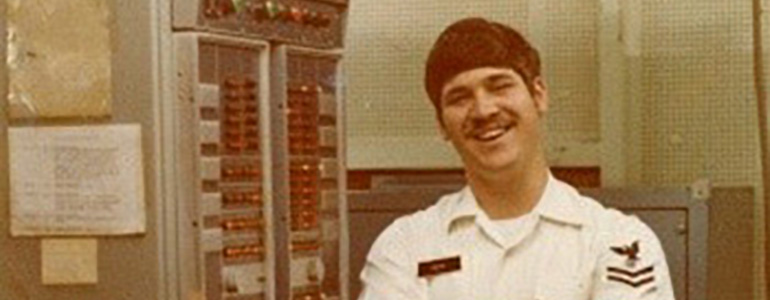By Jeff Sili, Vitech Principal Systems Engineer
Silicon Valley icon and industrial designer Steve Jobs had a favorite dictum when he spoke to young audiences. “Your work is going to fill a large part of your life, and the only way to be truly satisfied is to do what you believe is great work. And the only way to do great work is to love what you do.”
By way of introducing myself, I’d like to take you along as I reflect on my journey through the wilds of systems engineering, an adventure that has brought me to where I am today—the newest team member in Professional Services at Vitech.
I’m Jeff Sili, and I’ve been a systems engineer for nearly three decades. I hail from the “Rust Belt” near Cleveland, Ohio and had a great time growing up in a big, blue collar neighborhood. The community was interesting and diverse—a place where first and second generation grandparents were still speaking languages like German and Italian. My dad was a machinist-mechanic, and he gave me my first taste of what it was like to “take it all apart and put it back together again.” As a teenager in the ’70s, I watched the collapse of the economy in big cities like Cleveland, the demise of steel and other industries and with them, jobs.
I focused early on leaving that crumbling infrastructure behind, seeing the world and more importantly, getting the education to “take it apart and put it all back together again.” I knew I would study engineering and was focused on any system as a whole where mathematics and methodology allowed for attacking large-scale engineering problems. I joined the Navy, which provided me with my first great job and a system of my own to understand, service, and oversee. The Navy trained me to become a data systems technician, where I learned my craft from the ground up, working on a number of ships throughout my career. Those big, old, cumbersome early computers were my babies, and I loved what I was doing.
Early days at DOD
In 1983, I left the Navy to attend college on the GI bill. I received my degree in Electronic Engineering from Norfolk State. Dahlgren Naval Base in King George, Virginia was the place to be for what was then cutting-edge Department of Defense technologies. I landed a job at DOD, and before I knew it was working on my first major systems engineering project in support of the Aegis Weapon System. The rest, as they say, is history.
Back in the day, which seems like the Stone Age compared to today’s tools and technologies, the display console for the Aegis Weapon System was basically a dumb terminal driven by the Aegis Display System. The programming language then in use was called a Compiler Monitor System. This was an embedded, proprietary, tactical training system with a shore-based lesson authoring system. A sailor in the Combat Information Center could train at the console as if it were in a tactical situation. This was used to teach new skills and identify software improvements.
At the beginning of projects like this, there was always an evaluation of the existing requirements and a review of the expectations for any new requirements for the training system. Initial criteria were developed for use in the selection of a software product. As small teams evaluated existing and new requirements, they were then tasked with selecting software which could be adapted to interface with the newly emerging military technology, as opposed to the old standard. Remember, pretty much all we had back then were telephones; it was rare to see a desktop computer.
We compiled a list of all the potentially viable commercial Lesson Authoring Software vendors and other government agencies with Computer-Based Training products. Things we typically needed were Prototyping, System Requirements Specification (SRS), Software Design Documents (SDD) for the design phase, developmental tests, and so on. This drill went on for years.
Discovering CORE
In time, I was asked to work on some smaller projects that needed systems engineering early in the development phase and didn’t have a budget for full-time engineering staff. I looked for a way to capture the engineering process that would allow me to move back and forth between these smaller projects. It was during this search that I fortuitously found Vitech.
Vitech had a product called CORE that enabled the capture of all the design information in a single repository. It was during this time that I got my very first desktop computer and loaded CORE. Unlike anything I had used before, CORE would now allow me to come back to a project, quickly update, and deliver changes. While this may sound unremarkable, it was novel to find something that possessed this capability.
As the Aegis designs began to consist of more Commercial-Off-the-Shelf Technology (COTS), I began to realize the full functionality of this software. I started using my small CORE project tool for some of my big project reviews. It was like revealing the pieces of a big system puzzle as I learned to import all the data I had for a design review into a system engineering tool. I gained a great deal of insight that you don’t get from reading a specification. I was able to create the physical architecture with the interfaces and allocate the functions with the traced requirements. I did this for all the elements I was reviewing. This development process allowed me to ask very specific design questions early and develop skills in using a system engineering tool for quick evaluation.
I was, for all intents and purposes, hooked on my new-found friend in software, CORE, and would demonstrate this new process I had to various engineering groups and customers. Keep in mind that this was still not the true computer age where everyone is equipped with laptops.
We’ve always done it this way
Changing attitudes on our approach was sometimes difficult. I’ll admit that I ran up against a lot of, “We do it this way because we’ve always done it this way.” I began to have some success, however, with clients who were also looking for a more holistic avenue to developing and maintaining a systems engineering approach. About that time, in the early 2000s, Vitech introduced Department of Defense Architecture Framework (DODAF) capability into CORE, which greatly enhanced the product.
To illustrate my continuing conversion to a tool that I could count on to deliver, let me tell you about Bob (fictional name), a customer who was assembling a small team to develop a shipboard torpedo defense system. Bob had been using CORE for a project and now wanted to use it in a new product development. We did a number of searches for existing technology. We found starts and stops of projects and gathered all the documentation we could and assembled it in CORE, our single repository. From there, the team developed a functional architecture with requirements traced to it.
We briefed the sponsor regularly and provided documentation directly from CORE. It was decided that our sponsor should evaluate the second phase of our project. Using the documentation we provided, management decided to move the project to phase three, which would and did become the Torpedo Warning System (TWS).
TWS was an exciting project. It would have a number of innovative features, including a “Receive Array” launched from a large-deck ship. The Receive Array had as part of its design a winch at the end of the ship—essentially a towed sensor or receiver, which was engineered to detect the presence of an incoming torpedo. The Receive Array sent information up the tow cable to a processor which then computed key information. The processor then sent this data to an interceptor launcher attached to the side of the ship for projectiles or Countermeasures Anti-Torpedos. The team would review the design documents provided and regularly input new data into CORE. This allowed the team to quickly evaluate the updates and assess them against the logical architecture.
CORE became core to my professional expertise
As I moved on in my career, CORE became my preferred tool for just about every task I was assigned at any number of companies. One of my first questions when moving to a new project was, “Do you have a CORE license, and if not, how fast can we get one?”
The agility and diversity of CORE allowed me to move on a multitude of fronts—from developing logical and physical views of proposed architectures to framework reviews to Operational Sequence Diagrams to customized ones—as well as on endless scenarios and executable models.
Long story short, I loved working with CORE because it ensured that I delivered success to my clients. It allowed me to use my personal education and skillset, developed over years of practice, to create an end result that I was both personally and professionally proud of.
Fast forward to mid-October of 2016 when my wife and I discussed a major career change for me—to move to the private sector. The continuous battle to fund DOD in recent years had often overshadowed system projects I was working on. What I had witnessed time and again was this scenario: One would spend months, sometimes years, painstakingly nursing and enhancing projects, and would near a successful launch, only to have funding issues suddenly take precedence and halt the project altogether. I itched to contribute in an environment where I wasn’t constantly yanked off-track. The private sector beckoned.
 As the opportunity at Vitch presented itself, my wife said, “Look, for years, I’ve heard you sell the merits of CORE to every project manager on the face of the earth. You’ve been like a broken record,” she added laughing. “Maybe it’s time to go somewhere where they already understand this. Isn’t it just icing on the cake that you get to teach Model-Based Systems Engineering and the great points of this approach to customers?”
As the opportunity at Vitch presented itself, my wife said, “Look, for years, I’ve heard you sell the merits of CORE to every project manager on the face of the earth. You’ve been like a broken record,” she added laughing. “Maybe it’s time to go somewhere where they already understand this. Isn’t it just icing on the cake that you get to teach Model-Based Systems Engineering and the great points of this approach to customers?”
She was right.
Vitech provides a whole host of courses to introduce you to Model-Based Systems Engineering, CORE, and the newest product, GENESYS.
Again, my name is Jeff Sili, and I’d like to help you do really great work.






